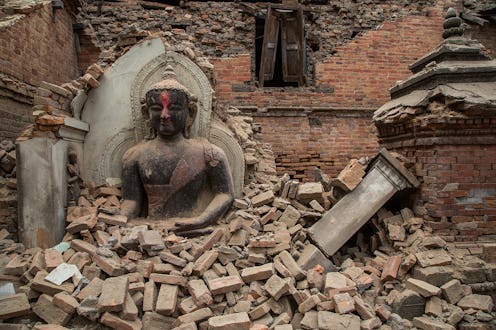News
Could There Be Another Nepal Earthquake?
As relief efforts continue and foreign aid enters the country, Nepal is reeling from Saturday’s devastating earthquake that left more than 2,200 people dead. The government, grappling with badly damaged infrastructure and more than 5,000 injured, has declared a state of emergency. Patients are being treated in the open-air, with countless more on the way, as countries across the world scramble to assemble assistance teams and aid packages. But the terror of the initial quake — which hit around noon local time Saturday — is far from over. Intense aftershocks continue to rock Nepal, terrifying residents and hindering rescue efforts.
The initial earthquake, measuring 7.8 on the Richter scale, was the most powerful to hit the region for 80 years. It also happened to be very shallow, with an epicenter only 11 kilometers below the earth’s surface. These factors, and its proximity to the densely populated capital city of Kathmandu (where at least 721 were reportedly killed), account for the immediate devastation caused. Its shallowness meant the ground-shaking at the surface was amplified, destroying buildings and prompting landslides and avalanches in the mountainous country.
That first quake has been followed in quick succession by a number of aftershocks. The most powerful, a magnitude 6.7 tremor, struck Sunday afternoon with an epicenter 40 miles east of Kathmandu. The aftershock was felt across Nepal, India, and Bangladesh, and precipitated more avalanches on Everest. “Another one, we have an aftershock right now. Oh shit! Avalanche!” Indian climber Arjun Vajpai shouted over the phone to Reuters from Makalu base camp near Everest. The news service reported that screams and the sounds of snow crashing down the mountain’s slopes could be heard. An avalanche following the initial quake killed at least 17 people at Base Camp.
Sunday’s 6.7 tremor was only one of a dozen aftershocks that have rattled the country — terrifying already traumatized residents, and prompting many to spend a cold and wet night outside. Despite the inclement weather and low temperatures, this seemed a better option than retreating inside, as buildings continued to periodically rattle. Sundar Sah, a resident of Kathmandu, told The Guardian:
There were at least three big quakes at night and early morning. How can we feel safe? This is never-ending and everyone is scared and worried. I hardly got any sleep. I was waking up every few hours and glad that I was alive.
The fear of aftershocks and building collapses (as well as overcrowding) led hospital staff to create makeshift operating theaters in hospital parking lots. Patients, too scared to remain inside, were treated from tents. Samir Acharya, a doctor at Annapurna Neurological Hospital, wept as he spoke with AP about their attempts to care for patients under such circumstances. “We have treated many people since yesterday, the majority children,” said Acharya. “Most patients have head injuries or fractures. Two of our patients died, two are critical.”
Tents have been set up in the center of Kathmandu to shelter thousands displaced by the natural disaster. The protracted shaking is clearly terrifying — but could the aftershocks result in another full-blown quake?
BBC Science correspondent Jonathan Amos offers insight into the likely knock-on effects of Sunday’s quake. “Large quakes are generally followed by a flurry of aftershocks, which tend to reduce in strength and frequency as time goes on,” he writes. Seismologists generally expect to witness at least one major aftershock — measuring about a magnitude less than the initial event. Several of these have already occurred in Nepal’s latest disaster, with a 6.6 tremor a half hour after Saturday’s 7.8 quake, then Sunday’s 6.7 tremor.
The latest large tremor appears to have been shallower than the initial quake, and despite its drop in energy from the first quake, Amos points out that residents would barely have registered the difference in magnitude. The shaking caused panic on the streets of Kathmandu.
Whether or not another earthquake hits, the aftershocks could topple already compromised buildings, as well as sparking landslips and avalanches. They’ve also left many effectively shelter-less, and could stymie efforts to rescue survivors. Aftershocks have previously proved even deadlier than initial quakes. A magnitude 7.1 earthquake in New Zealand in 2010 left no one dead, but a 6.1-magnitude aftershock of that original event — striking months later — killed 185 people.
Nepal is one of the most earthquake-prone countries in the world, with Kathmandu ranking as the city most vulnerable to earthquakes according to a 2001 study. In 1934, an 8.0 magnitude quake known as the Bihar-Nepal earthquake left 16,000 dead across India and Nepal. Less devastating Nepalese earthquakes in the 21st century racked up a death toll of 20, prior to Saturday’s quake.
The seismic activity is due to Nepal’s situation on the boundary of the Indian subcontinent and the Eurasian tectonic plate. The India tectonic plate is pushing northwards into central Asia, at a rate of 5 centimeters a year. This movement results in “thrust-faulting” (in which rocks in a lower stratigraphic position are pushed up and over higher strata), which has elevated the Himalayan mountain range. And, as a side-effect, generates earthquakes — including Kashmir’s 2005 earthquake that left more than 80,000 dead.
Aid from countries as far-flung as Sri Lanka, Britain, Australia, the U.S., and China, is now on its way to a devastated Nepal. Both Australia and Britain have pledged substantial aid packages, with AUS$5 million from the former and £5 million ($7.5 million) from the latter. Indian planes, bearing relief goods, medical equipment, and rescue workers arrived Sunday.
Images: Getty Images (4)
